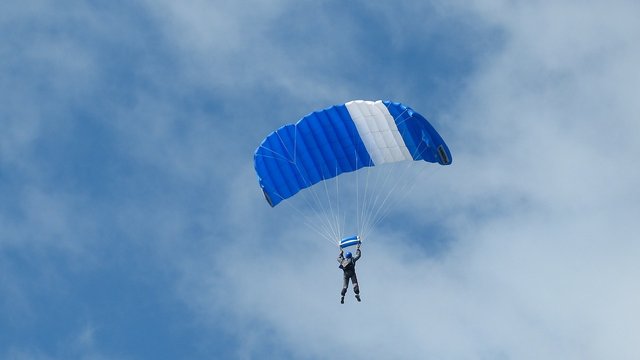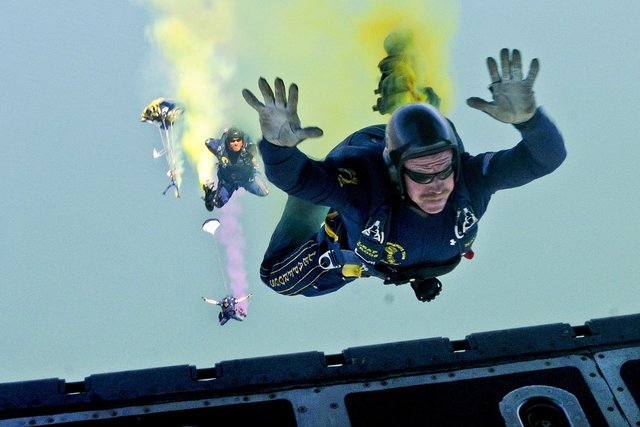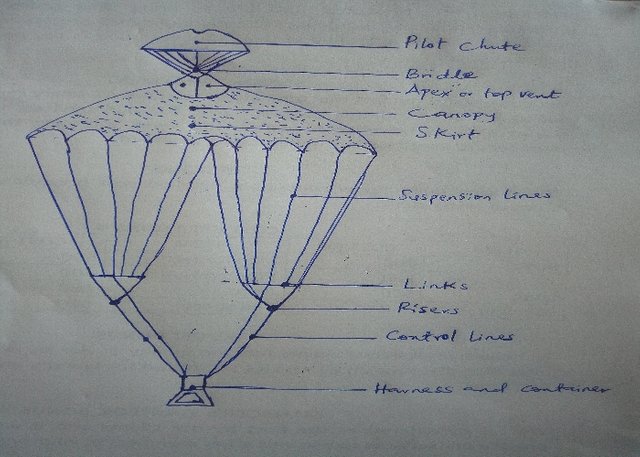Understanding The Science of Parachutes (Part 2)

[Source: Pixabay commons. CC0 licensed]
Welcome to this concluding part of the article on Understanding the science of parachutes. In part one, we demonstrated at length how two things released from a skyscraper under the influence of free fall would get to the ground at the same time because they are both only acted upon by force of gravity which is relatively constant throughout the world. We also discussed how parachutes were designed to ensure their rates of acceleration through the air molecules is substantially reduced by air resistance which constitutes a drag force against the acceleration of the freely falling body. In this part two, we are going to be looking at the concept of terminal velocity and how it affects a body under the influence of gravity. And finally how different sizes of parachutes affect their acceleration.
Terminal velocity
Terminal velocity is defined as...:
...the highest velocity that can be achieved by an object that is falling through a fluid, such as air or water. When terminal velocity is reached, the downward force of gravity is equal to the sum of the object's buoyancy and the drag force. An object at terminal velocity has zero net acceleration..| Source

[Demonstrating how terminal velocity occurs. Source: Wikimedia commons. Author: Neurolysis. CC BY-SA 4.0 licensed]
In the above image, terminal velocity is reached when the sum of the drag force (Fd) and the buoyancy acting upwardly on the object is equal to the downward force of gravity FG. Because, the two forces are not only equal but are said to be acting in opposition to each other, there is no net force. And hence acceleration is zero [ref].
Ideally, there is nothing like indefinite increment in speed for a body that is falling under the influence of gravity. When an object is released from a height, it gains speed and moves quickly only up to a certain point and stop accelerating. This is because as the speed of body increases, so is the drag force acting on it against the direction of gravitational pull. This will continue until a certain point where the downward force of gravitational pull is equal to the upward drag force. When this occurs, the body will cease to accelerate but will keep falling at a steady speed called Terminal velocity.
Equation wise, below is the formula for finding terminal velocity, Vt:
Vt = (2mg/ρACd)1/2
Where...
Vt ~ terminal velocity
m ~ mass of the object
g ~ acceleration due to gravity
Cd ~ drag coefficient
ρ ~ density of the medium through which the object is passing through as it falls
A ~ Cross section area of the object
The amount of drag force acting against a falling body depends mainly on the body's cross-sectional area, and will increase with increasing cross-sectional area of the body. A parachute, with its large cross-sectional area relative its mass, has a lower terminal velocity compared to a body (say bullet) with considerably smaller cross-sectional area relative to its mass. The terminal velocities for a falling person is reported to be within 56 — 76 meters per second. Based on average, the terminal velocity should be 60 meters per seconds. However, this value varies with the person's weight and the body orientation during the fall.

[Belly to earth falling orientation. Source: Pixabay commons. CC0 licensed]
For instance, the terminal velocity for a person falling in a belly-to-earth position which is also known as face-down position with his legs and arms widely stretched out to project a large cross-sectional area, is known to be about 193km/h (120miles/hour). But if the person is falling in a headfirst position, the terminal velocity rapidly increases to 322km/h (200miles/hour) because of significantly reduced projected cross-sectional area. Either of these terminal velocities is still very fast enough to kill any human being on impact with the ground! One way to lower this terminal velocities so that the person land safely is by use of a parachute. Let's see how this is achieved.
How much a parachute slow a falling person down
A sheet of paper released from the same height with a stone, would fall more slowly and should get to the ground at much later time than the stone because it has a significantly lower terminal velocity. Hence, parachutes are generally designed to lower terminal velocity by at least 90% through projecting a larger cross sectional area which rapidly increases the amount of drag force against a falling person so that the person hits ground at a much lower speed. During skydiving activity, the downward gravitational pull is overwhelmed once parachute is opened. This creates an upward net force on the falling skydiver and considerably lowers his speed to say 5 to 6 meters per seconds, which is equivalent to 20km/h or 12mph and very safe for the skydiver.
Some parts of a parachute and their functions
A parachute is made up of different components with each performing a specific function. The below freehand sketch of a parachute is not a complete representation of all the components of a parachute, but only some major ones.

[A self drawn freehand sketch]
Pilot chute: This is a small parachute that aids in the opening of the main parachute.
Bridle: This functions to join the pilot chute and the main chute together.
Apex or top vent: This is an opening that allows a slow escape of air from the top of the main chute in order not to rock the normal functioning of the chute when air escapes from the sides of the canopy.
Canopy: This is the major part of a parachute that is found in the upper part of the canopy.
Skirt: this is the lower part of the canopy.
Suspension lines: These help in the even distribution of the weight of a parachutist across the canopy.
Links: This is the point that joins suspension lines to the risers.
Risers: This is the point that joins the links to the harness.
Control lines: These are actually several in number and are used for steering and breaking purposes.
Harness and container: Harness is made up of numerous components, which together represents the part that people wear. Container, like its name, is primarily used to house the packed-up parachute, holding it in readiness for action.
Deploying a parachute in practice
When we watch soldiers in action movies jump off plane and deploy their parachutes above them, everything looks simple as though it is an easy task. Far from that; it is no easy task by any standard. A parachutist who jumps off a plane is probably at 10 times faster than a typical race car, and it is under this condition that he is expected to deploy the parachute so that it opens uniformly above and behind him! The canopy opening has to be UNIFORM, otherwise..... The outcome is better not imagined.
A typical parachute is actually made up of three chutes that are carefully packed into a single backpack known as **the container. These three chutes include the main chute, a reserve chute that becomes the next available option in the event of failure of the main chute, and the pilot chute that aids in the opening of the main chute. After a parachutist is off the plane, he first triggers the pilot chute. The pilot chute then opens up above the parachutist, and while doing so generate enough force that draw the main chute out of the container.
.jpg)
[Parachute deploying. Source: Wikimedia commons. Author: Richard Schneider. CC BY 2.0 licensed]
Care must be taken while packing the main chute to ensure it is properly packed in order for ropes of suspension lines not to get entangled, which may make the opening of the main chute in the next action difficult with increased risk of crash.
Generally, main chutes are designed to open gently and gradually to ensure parachutists do not suffer fractures, and the canopy is not torn into pieces by sudden jerks, which would have been the case if the main chutes are designed to open suddenly. Once safely deployed, the person continues to enjoy the sway while manipulating the direction of the parachute via control lines. This continues until the person touches the ground very safely.
Thanks for reading.
References for further reading
- Parachuting
- Skydiving: how fast can you fall through the air?
- Terminal velocity and free fall
- Skydiving
- Parachutes
- What's the Science behind parachute?
- Drag air resistance terminal velocity
- Terminal velocity
- Parachutes
Yours truly,
@eurogee
Do You Blog About Science, Technology, Engineering, and Mathematics? If Yes, Patiently Read The Below Info


Join Euronation Community on Telegram and whatsapp through the below links to socialize with larger steemit community:

No Witnesses = No Steem Blockchain; If You Truly Love Here, Vote For Witnesses NOW!
Click This Link To Vote Now


Wow .. This is another educative one from the boss himself, never knew so much principles is attached to parachute till now... Keep this up bro
Thanks boss
Well explained, but difficult to understand. I think this content is not for everyone, only who have some background in physics can understand.
if there are blogs that are very informative all the time, this is one of it. I never knew parachute is this complex. thanks for sharing boss
Thanks for checking this out ma'am
Okay, I anticipated this concluding part and now I am glad I got it within the first thirty minutes.
From my little knowledge of physics I could guess correctly from the equation that the terminal velocity of a typical parachute will be way lower than that of a body like man (since mass is a numerator and cross-sectional area a denominator in the equation). I hope I am right.
Lessons learned : application of the concept of terminal velocity in the designing of parachutes, parts and functions of a parachute, and precautions to be taken in the usage of it (I would have loved to be taught practically though) May be you can try it out, video yourself on action and share the video.
Great post sir! @eurogee
Thanks for a well thought out comment.
Not a bad idea to start with you😉
Regards
Hahahehe, I would have loved to but, its your field Sir. I am only a biologist and I should die as one.
Congratulations! Your post has been selected as a daily Steemit truffle! It is listed on rank 7 of all contributions awarded today. You can find the TOP DAILY TRUFFLE PICKS HERE.
I upvoted your contribution because to my mind your post is at least 18 SBD worth and should receive 152 votes. It's now up to the lovely Steemit community to make this come true.
I am
TrufflePig, an Artificial Intelligence Bot that helps minnows and content curators using Machine Learning. If you are curious how I select content, you can find an explanation here!Have a nice day and sincerely yours,

TrufflePigThis post has been voted on by the steemstem curation team and voting trail.
There is more to SteemSTEM than just writing posts, check here for some more tips on being a community member. You can also join our discord here to get to know the rest of the community!
Test
that good adventure thanks for sharing your moment success
Educational and fun to read :)
Too scientific content.Nicely explained @eurogee .
Please do check out my post to receive free 15,000 XRP0 coins.
https://steemit.com/bitcoin/@jitesh/free-15-000-xrp0-coins